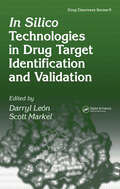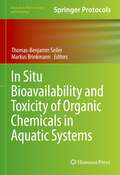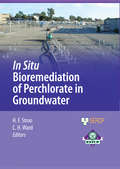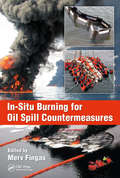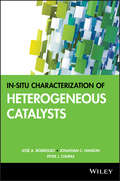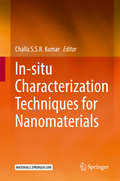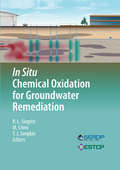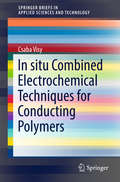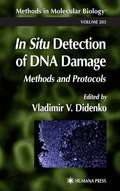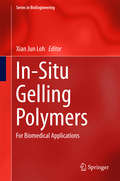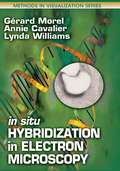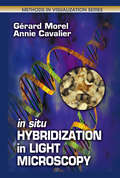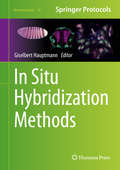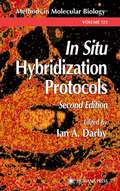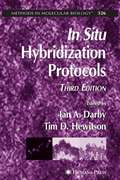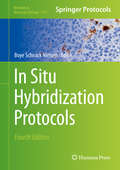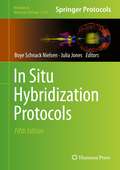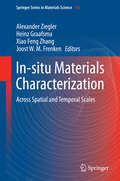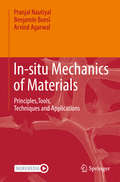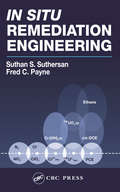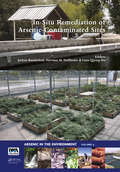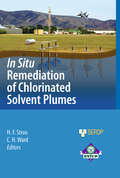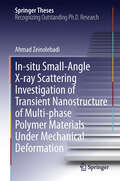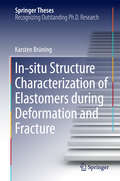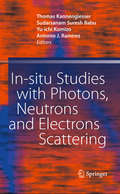- Table View
- List View
In Silico Technologies in Drug Target Identification and Validation (Drug Discovery Series)
by Darryl León Scott MarkelThe pharmaceutical industry relies on numerous well-designed experiments involving high-throughput techniques and in silico approaches to analyze potential drug targets. These in silico methods are often predictive, yielding faster and less expensive analyses than traditional in vivo or in vitro procedures. In Silico Technologies in Drug Target Ide
In Situ Bioavailability and Toxicity of Organic Chemicals in Aquatic Systems (Methods in Pharmacology and Toxicology)
by Thomas-Benjamin Seiler Markus BrinkmannThis detailed volume examines the complex study of the assessment of in situ bioavailability and toxicity of organic chemicals in aquatic systems with a toolbox of reliable techniques. Beginning with a section on approaches for chemical analytical and bioanalytical techniques in bioavailability research, the book continues with methods to monitor effects in situ and conduct bioassays to assess the effects of complex environmental samples. It concludes with descriptions of various computational models. Written for the Methods in Pharmacology and Toxicology series, chapters feature the kind of expert implementation advice that leads to greater success in the field. Authoritative and versatile, In Situ Bioavailability and Toxicity of Organic Chemicals in Aquatic Systems serves as an ideal guide to aid in tackling the challenge of analyzing and understanding chemical pollution in aquatic systems.
In Situ Bioremediation of Perchlorate in Groundwater
by C. Herb Ward Hans F. StrooThis volume presents a critical analysis and timely synthesis of the past decade of intensive research, development, and demonstrations on the in situ bioremediation of perchlorate in groundwater. The intended audiences include the decision makers, practicing engineers and hydrogeologists who will select, design, and operate these remedial systems, as well as researchers seeking to improve the current state-of-the-art. Our hope is that this volume will serve as a useful resource to assist remediation professionals in applying and developing the technology as effectively as possible. An overview of the current state-of-understanding of perchlorate remediation is followed by a discussion of basic principles of microbial and abiotic processes, and of the engineering and implementation issues underlying the technologies described. Characterization of both anthropogenic and natural sources of perchlorate, including isotopic analysis to distinguish between differing sources, precedes discussions of the advantages, performance, and relative costs of applying a range of remedial technologies. Active, semi-passive, and passive in situ bioremediation are fully described and compared with emphasis on field application. Cost information for each technology, using case studies and analyses of several template sites, covers capital costs, as well as costs for laboratory testing, pilot-scale demonstration, design, system operation, monitoring and maintenance during operations, and demolition and restoration after remediation. In addition, analogous cost data are presented for pump-and-treat systems for each template site to illustrate the potential cost savings associated with the use of alternative approaches. Emerging technologies such as monitored natural attenuation, phytoremediation, and vadose zone bioremediation are described, and field demonstrations are used to illustrate the current stage of maturity and the potential applicability of these approaches for specific situations.Each chapter in this volume has been thoroughly reviewed for technical content by one or more experts in each subject area covered.
In-Situ Burning for Oil Spill Countermeasures
by Merv FingasShelving Guide: Environmental Engineering In-situ burning is recognized as a viable alternative for cleaning up oil spills on land and water. It can rapidly reduce the volume of spilled oil and eliminate the need to collect, store, transport, and dispose of recovered oil, and can also shorten the response time to a spill, thus reducing the chances that the spill will spread on the water surface or further into land. This book will serve as a comprehensive reference for all aspects of in-situ burning of oil spills and include the scientific aspects of the burning process and the related effects, as well as practical information about the procedures to be followed and equipment required for carrying out an in-situ burn. Features Serves as a complete source of information on in-situ burning as well as practical guide on how to implement the procedures. Explains procedures for burning in different situations, including on water, land, and ice. Provides information on worker health and safety precautions during burning. Covers several different types of emissions, their environmental fate, and how to monitor them. Includes numerous illustrative case studies.
In-situ Characterization of Heterogeneous Catalysts
by José A. Rodriguez Jonathan C. Hanson Peter J. ChupasHELPS RESEARCHERS DEVELOP NEW CATALYSTS FOR SUSTAINABLE FUEL AND CHEMICAL PRODUCTION Reviewing the latest developments in the field, this book explores the in-situ characterization of heterogeneous catalysts, enabling readers to take full advantage of the sophisticated techniques used to study heterogeneous catalysts and reaction mechanisms. In using these techniques, readers can learn to improve the selectivity and the performance of catalysts and how to prepare catalysts as efficiently as possible, with minimum waste. In-situ Characterization of Heterogeneous Catalysts features contributions from leading experts in the field of catalysis. It begins with an introduction to the fundamentals and then covers: Characterization of electronic and structural properties of catalysts using X-ray absorption fine structure spectroscopy Techniques for structural characterization based on X-ray diffraction, neutron scattering, and pair distribution function analysis Microscopy and morphological studies Techniques for studying the interaction of adsorbates with catalyst surfaces, including infrared spectroscopy, Raman spectroscopy, EPR, and moderate pressure XPS Integration of techniques that provide information on the structural properties of catalysts with techniques that facilitate the study of surface reactions Throughout the book, detailed examples illustrate how techniques for studying catalysts and reaction mechanisms can be applied to solve a broad range of problems in heterogeneous catalysis. Detailed figures help readers better understand how and why the techniques discussed in the book work. At the end of each chapter, an extensive set of references leads to the primary literature in the field. By explaining step by step modern techniques for the in-situ characterization of heterogeneous catalysts, this book enables chemical scientists and engineers to better understand catalyst behavior and design new catalysts for green, sustainable fuel and chemical production.
In-situ Characterization Techniques for Nanomaterials
by Challa S.S.R. KumarSeventh volume of a 40 volume series on nanoscience and nanotechnology, edited by the renowned scientist Challa S.S.R. Kumar. This handbook gives a comprehensive overview about In-situ Characterization Techniques for Nanomaterials. Modern applications and state-of-the-art techniques are covered and make this volume an essential reading for research scientists in academia and industry.
In Situ Chemical Oxidation for Groundwater Remediation
by Robert L. Siegrist Michelle Crimi Thomas J. SimpkinThis volume provides comprehensive up-to-date descriptions of the principles and practices of in situ chemical oxidation (ISCO) for groundwater remediation based on a decade of intensive research, development, and demonstrations, and lessons learned from commercial field applications.
In situ Combined Electrochemical Techniques for Conducting Polymers
by Csaba VisyThis book outlines methods to improve functioning of these polymer based devices - in particular, the multi-faceted cognition of these materials. In situ electrochemical techniques are studied to elucidate redox switching between non-conducting and conducting states. The book examines the advantages of combinations of in situ electrochemical techniques in a hyphenated mode for analyzing conducting polymers.
In Situ Detection of DNA Damage
by Vladimir V. DidenkoIn In Situ Detection of DNA Damage: Methods and Protocols, Vladimir Didenko and a panel of experts describe all the major in situ techniques for studying DNA damage and apoptosis, and how approaches originally designed to label apoptotic cells can be used for DNA damage analysis (and vice versa). The readily reproducible techniques presented here include all those designed to detect specific single- and double-stranded DNA breaks in tissue sections while using polymerases, ligases, nucleases, and kinases. There are also novel instrumental techniques that use ultrasound for in vivo and in situ detection of apoptotic DNA damage, and in situ applications of flow and laser-scanning cytometry for analysis of DNA strand breaks and apoptosis. State-of-the-art and highly practical, In Situ Detection of DNA Damage: Methods and Protocols presents for the first time a complete set of enzymatic methods for determining DNA breaks, and will greatly facilitate the work of all those studying the in situ detection of DNA damage and the labeling of apoptotic cells.
In-Situ Gelling Polymers
by Xian Jun LohThis book presents the research involving in situ gelling polymers and can be used as a guidebook for academics, industrialists and postgraduates interested in this area. This work summaries the academic contributions from the top authorities in the field and explore the fundamental principles of in situ gelling polymeric networks, along with examples of their major applications. This book aims to provide an up-to-date resource of in situ gelling polymer research.
In Situ Hybridization in Electron Microscopy
by Gerard Morel Annie Cavalier Lynda WilliamsIn situ hybridization is a technique that allows for the visualization of specific DNA and RNA sequences in individual cells, and is an especially important method for studying nucleic acids in heterogeneous cell populations. in situ Hybridization in Electron Microscopy reviews the three main methods developed for the ultrastructural visualization
In Situ Hybridization in Light Microscopy (Methods in Visualization)
by Gerard Morel Annie CavalierIn Situ hybridization allows the visualization of specific DNA/RNA sequences in individual cells in tissue sections, single cells, or chromosome preparations, and is an especially important method for studying DNA and RNA in heterogeneous cell populations. This book delves into in situ hybridization methods through the use of light microscopy used
In Situ Hybridization Methods
by Giselbert HauptmannThis volume contains a comprehensive compilation of chromogenic and fluorescent RNA in situ hybridization (ISH) technology in many of its various shades, forms, and applications. The book is organized into a number of parts and chapters focusing on the application of ISH methodologies to different animal species as used in Evolutionary Development (EvoDevo) and Biomedical research, and covering new developments in RNA visualization by fluorescent ISH (FISH). The described (F)ISH protocols employ effective strategies for signal enhancement and target amplification allowing for high signal intensities and drastically improved signal-to-noise ratios. Chromogenic and fluorescent ISH, as specified in the various chapters, are most essential for RNA expression profiling, applied to many fields of research including cellular, developmental, and evolutionary biology, neurobiology and neuropathology. Written for the popular Neuromethods series, chapters include the kind of detail and key implementation advice that ensures successful results in the laboratory. Essential and authoritative, In Situ Hybridization Methods provides detailed protocols for newcomers to ISH, and inspires researchers familiar with the technique to seek and find up-to-date methodology for new and specialized applications.
In Situ Hybridization Protocols
by Ian A. DarbyIan Darby updates the highly successful premier edition with a full panoply of new and greatly augmented state-of-the-art techniques. This valuable new edition contains basic and advanced in situ hybridization techniques-many not covered in the first edition-and includes protocols for in situ hybridization of whole-mount embryo specimens, in situ hybridization at the electron microscope level, in situ detection of DNA fragmentation in apoptosis, localization of genes to particular chromosomes, and the use of DNA or RNA probes to detect expression in cells or tissue sections. Prepared by leading investigators who have daily worked with the techniques, fine-tuning them for reliability, In Situ Hybridization Protocols, 2nd Edition, offers a completely updated and extended collection of proven and readily reproducible methods suitable for both the novice and experienced investigator. Its state-of-the-art protocols constitute the new standard methods resource in the field, one that will enable researchers successfully to enhance and improve their current experimental repertoire.
In Situ Hybridization Protocols
by Tim D. Hewitson Ian A. DarbyThis revised and updated edition of a recognized classic emphasizes tissue and cell in situ hybridization methods. Among the new techniques detailed are PNA probes for viral diagnostics, plant in situ hybridization, cell proliferation detection, and quantitation of in situ hybridization. There are also cutting-edge techniques for tissue microarrays, expanded embryology-developmental gene detection, and expanded cell culture. Derivative techniques presented include identification of transplanted cells, histones, nick-end labeling for apoptosis, the use of peptide nucleic acid probes, and in situ hybridization of plant specimens. The protocols follow the successful Methods in Molecular BiologyTM series format, each offering step-by-step laboratory instructions, an introduction outlining the principles behind the technique, lists of the necessary equipment and reagents, and tips on troubleshooting and avoiding known pitfalls.
In Situ Hybridization Protocols (Methods in Molecular Biology #1211)
by Boye Schnack NielsenIn Situ Hybridization Protocols, Fourth Edition contains 21 protocols that utilize the in situ hybridization technology to document or take advantage of the visualization of specific RNA molecules. Written in the highly successful Methods in Molecular Biology series format, chapters include introductions to their respective topics, lists of the necessary materials and reagents, step-by-step, readily reproducible laboratory protocols, and tips on troubleshooting and avoiding known pitfalls.Authoritative and practical, In Situ Hybridization Protocols, Fourth Edition seeks to aid scientists in the further discovery of new RNA species and uncovering of their cellular functions.
In Situ Hybridization Protocols (Methods in Molecular Biology #2148)
by Boye Schnack Nielsen Julia JonesThis fifth edition volume expands on the previous editions with updated discussions on the many new in situ hybridization (ISH) techniques used by researchers today. New developments in probe designs, detection systems, specificity and sensitivity improvements, and multiplexing combinations are explored. Chapters in this book are organized into seven sections and cover general applications; methods for DNA ISH; methods for cultured cells; methods for wholemount and plant material; automated methods for RNA; multiplexing and combined methods; and targeted selective methods and single molecule detections. Written in the highly successful Methods in Molecular Biology series format, chapters include introductions to their respective topics, lists of the necessary materials and reagents, step-by-step, readily reproducible laboratory protocols, and tips on troubleshooting and avoiding known pitfalls.Cutting-edge and thorough, In Situ Hybridization Protocols, Fifth Edition is a valuable resource for both novice and expert scientists interested in learning more about this exciting and advancing field.
In-situ Materials Characterization
by Alexander Ziegler Heinz Graafsma Xiao Feng Zhang Joost W. M. FrenkenThe behavior of nanoscale materials can change rapidly with time either because the environment changes rapidly or because the influence of the environment propagates quickly across the intrinsically small dimensions of nanoscale materials. Extremely fast time resolution studies using X-rays, electrons and neutrons are of very high interest to many researchers and is a fast-evolving and interesting field for the study of dynamic processes. Therefore, in situ structural characterization and measurements of structure-property relationships covering several decades of length and time scales (from atoms to millimeters and femtoseconds to hours) with high spatial and temporal resolutions are crucially important to understand the synthesis and behavior of multidimensional materials. The techniques described in this book will permit access to the real-time dynamics of materials, surface processes and chemical and biological reactions at various time scales. This book provides an interdisciplinary reference for research using in situ techniques to capture the real-time structural and property responses of materials to surrounding fields using electron, optical and x-ray microscopies (e. g. scanning, transmission and low-energy electron microscopy and scanning probe microscopy) or in the scattering realm with x-ray, neutron and electron diffraction.
In-situ Mechanics of Materials: Principles,Tools, Techniques and Applications
by Pranjal Nautiyal Benjamin Boesl Arvind AgarwalThis is the first comprehensive book to address in-situ mechanics approach, which relies on real-time imaging during mechanical measurements of materials. The book presents tools, techniques and methods to interrogate the deformation characteristics of a wide array of material classes, and how the mechanics and the material microstructures are correlated. In-situ approach provides unprecedented ability to decipher the mechanical behavior of materials from atomic length scales all the way up to bulk-scale, which is not possible using conventional means. The book also addresses how to capture the deformation behavior of materials under different stress-states and extreme environments. The book will be useful to the new generation of students, scientists and researchers working on the frontiers of material design and innovation as they aim to develop new materials with predictable mechanical properties and technological applications. This book can also serve as a textbook aimed at upper-level undergraduates and graduate-level students who are beginning to delve into the mechanics of materials. Catering to a generation of students that appreciates videos as a didactic tool, this book contains numerous videos to supplement problems, solutions, and case studies.
In Situ Remediation Engineering
by Suthan S. Suthersan Fred C. PayneIn Situ Remediation Engineering provides a comprehensive guide to the design and implementation of reactive zone methods for treatment of all major classes of groundwater contamination. It teaches the fundamentals that underlie development of cost-effective reactive zone strategies, guides the selection of cost-effective remedial strategies and provides environmental engineers and scientists with tools to achieve optimal deployment of source area, reactive barrier, and site-wide treatments. It offers extensive coverage of remedial system operation, discussing reagent injection strategies, interpretation of process monitoring results for biological and chemical reactive zone systems, and impacts of treatment processes on aquifer hydraulic characteristics.
In-Situ Remediation of Arsenic-Contaminated Sites (Arsenic in the environment)
by Jochen Bundschuh Hartmut M. Holländer Lena Qiying MaProviding an introduction, the scientific background, case studies and future perspectives of in-situ arsenic remediation technologies for soils, soil water and groundwater at geogenic and anthropogenic contaminated sites. The case studies present in-situ technologies about natural arsenic, specifically arsenate and arsenite, but also about organic arsenic compounds. This work covers geochemical, microbiological and plant ecological solutions for arsenic remediation.It will serve as a standard textbook for (post-)graduate students and researchers in the field of Environmental Sciences and Hydrogeochemistry as well as researchers, engineers, environmental scientists and chemists, toxicologists, medical scientists and even for general public seeking an in-depth view of arsenic which had been classed as a carcinogen. This book aims to stimulate awareness among administrators, policy makers and company executives of in-situ remediation technologies at sites contamined by arsenic and to improve the international cooperation on the subject.
In Situ Remediation of Chlorinated Solvent Plumes
by C. Herb Ward Hans F. StrooThis volume provides a review of the past 10 to 15 years of intensive research, development and demonstrations on the in situ remediation of dissolved chlorinated solvents. The intended audience includes the decision makers and practicing engineers and hydrogeologists who will select, design and operate these remedial systems, as well as researchers seeking to improve the current state-of-the-art. Our hope is that this volume will serve as a useful resource to assist remediation professionals in applying and developing the technology as effectively as possible.
In-situ Small-Angle X-ray Scattering Investigation of Transient Nanostructure of Multi-phase Polymer Materials Under Mechanical Deformation
by Ahmad ZeinolebadiThe results in this dissertation set the ground to answer a fundamental question in data-driven polymer material science: "Why don't prepared composites show less fatigue than the pure plastics?" A simultaneous analysis of mechanical testing and small angle X-Ray scattering from the DESY source in Hamburg has been applied to approach this question, which is also central to the European research project "Nanotough", and the results are clearly presented in this book. The evolution of the materials structure is visualized and quantitatively analyzed from exhaustive sequences of scattering images. Three different classes of polymer composites are presented as typical and illustrative examples. The obtained results illustrate that the interactions of their components can cause unpredictable structural effects, ultimaltely leading to a weakening of the material, where a reinforcement was expected.
In-situ Structure Characterization of Elastomers during Deformation and Fracture
by Karsten BrüningThis thesis offers novel insights into the time-dependent structural evolution of polymers under deformation. In-situ tensile experiments at high-brilliance synchrotron sources allowed to characterize the material with unrivaled resolution in time and space. The strain-induced crystallization in natural rubber was studied by wide-angle X-ray diffraction. Special emphasis was put on the establishment of new structure-property relationships to give a more in-depth understanding of the mechanical performance of rubber parts, e. g. in tear fatigue loading. To this end, the kinetics of strain-induced crystallization were investigated, subjecting the material to high strain rates. The local structure around a crack tip was observed by scanning wide-angle X-ray diffraction. Ultra-small angle X-ray scattering served to study filled elastomers under deformation, from specially prepared model filler systems to industrially relevant carbon black filled rubbers. Other methods include electron microscopy coupled with in-situ tensile testing and optical dilatometry to examine cavitation in rubbers. The underlying theory as well as a literature review are covered by an extensive introductory chapter, followed by a description of the experimental techniques. The results are presented in more detail than in the original journal publications.
In-situ Studies with Photons, Neutrons and Electrons Scattering
by Sudarsanam Suresh Babu Thomas Kannengiesser Antonio J. Ramirez Yu-Ichi KomizoIn-situ scattering and diffraction measurements using synchrotron and neutron beam lines have become a viable tool to look at the non-equilibrium processing of advanced materials. This volume presents the subject from the theoretical and experimental standpoint, in order to provide a closer insight into the different synchrotron and neutron diffraction techniques as well as innovative microscopy techniques. It addresses the following items: - Phase detection and quantification - In-situ welding experiments - Stress/strain build-up - Model development and Simulation - Analysis tools and programming
